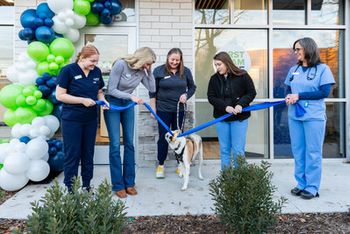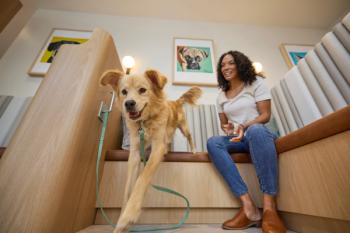
Here we grow again
Growing their facility 300 percent in just five years has served these doctors well. New services and more space mean greatly enhanced patient care.
Before the doors opened for the first time at the Veterinary Specialty Center of Tucson in 2004, the practice owners were already planning for future expansion. A mere five years after winning a Veterinary Economics Hospital Design Competition Merit Award for their new facility, founding owners Drs. James Boulay and Barbara Gores are celebrating yet another win—for the 20,000-square-foot addition and renovation of their specialty and emergency practice.
As soon as the doctors moved into their 10,000-square-foot facility in 2004, they approached their next-door neighbor, a landscaper, about buying his land for future expansion. In fact, Dr. Boulay offered to pay the landscaper’s mortgage if he would agree to sell him the land eventually. The landscaper agreed, and within a year he closed his business. The doctors immediately started planning yet another building project.
“We knew we’d need to build again, but we didn’t think it would come this quickly,” Dr. Boulay says.
The practice was growing by 25 percent a year, and, knowing that a building expansion takes at least a couple of years to plan and construct, the doctors decided to jump right in.
“This gave us a chance to do all the things we wanted to do in the original building but couldn’t because of cost restrictions,” Dr. Boulay says. “After seeing our success, the bank was very supportive in loaning us the money for the expansion. We knew it would give us the hospital that Dr. Gores and I envisioned from the very beginning.”
EXPANDING CAPABILITIES FOR PATIENT CARE
With a much larger facility comes a greater ability to care for patients. This expansion, which tripled the size of the original facility, brought with it many new services for the practice. Most importantly, the doctors needed a second radiology suite. “Most of our bottlenecks occurred in radiology,” Dr. Boulay says. A second suite brought the addition of fluoroscopy services as well.
Next, they added a separate CT room and MRI capabilities. “The ability to do all of this imaging really solved a huge technical crisis for our clinic,” Dr. Boulay says.
The addition of iodine-131 for treating cats with hyperthyroid disease raised the level of care, as did the addition of physical therapy and rehabilitation. “One of our emergency doctors who is also a minority owner of the practice had a stroke and can’t perform as an ER doctor anymore,” Dr. Boulay says. “Because of her experience with her own rehabilitation, she has become certified to rehabilitate our animal patients. It’s a neat connection she now has with her patients.”
Lastly, the expanded centralized ICU brought with it cardiac telemetry, just like a human hospital would use. The facility has a screen on the wall that shows continuous ECG readings for up to eight dogs at a time. The dogs wear a battery pack on their backs, and readings are sent straight to the monitors in the doctors’ station. “We’re excited about this addition, because it offers us much better patient care,” Dr. Boulay says. “Now we can offer full-service care to our patients.”
With a hospital of this size, the doctors worried about their impact on the environment. Installing solar panels helped reduce their energy costs substantially—while earning tax credits from the local and federal government as well as from the local energy companies.
“Living in Arizona, where the sun shines all the time, it made sense for us to use solar energy,” Dr. Boulay says. “We have solar energy at our house, and never have to pay an electric bill. We decided to bring this savings to our hospital.”
The doctors incorporated a parking structure that features solar panels on top. The 60 kilowatt system cuts the hospital’s energy needs by 25 to 40 percent, and will pay for itself in about four years.
Photos by Wayne Tremblay
UNDER CONSTRUCTION
Despite the construction project going on all around them, the doctors and team members managed to keep the practice up and running the entire time, thanks in part to a complicated, phased-construction plan. First, the crew built the entire expansion. Once finished, surgery moved into the new facility. And thus began an eight-month rotation of services, moving in and out of spaces and waiting for various parts of the hospital to be finished.
“It took a whole year of planning to make it work this well, but we never missed a single day of work,” Dr. Boulay says.
RAISING THE LEVEL OF CARE
In keeping with the practice’s efforts to raise the level of care for all pets, the doctors included a conference center that seats 150 for all kinds of continuing education efforts. The hospital offers CE for local veterinarians, team members, and the general public, and they hope to eventually hold national meetings.
“We want to give back to our community by helping educate them about all things pet-related,” Dr. Boulay says. “The local community has provided us with a successful practice. The more you raise the level of expertise in the community, the more the pets benefit.”
Dr. Boulay says the doctors see their practice as an extension of the veterinary community at large. Family veterinarians are specialists in their own right, he says, and he wants his practice to be seen as an extension of that care. “When general practitioners need more specialized care or equipment that they can’t provide in-house, we want to share in getting that pet healthy again,” he says. “We don’t want to take the place of that veterinarian, but to work with him or her to give patients the most comprehensive and advanced care they may need. And this facility is a great way to offer the best care possible.”
Veterinary Specialty Center of Tucson
4909 N. La Canada Drive
Tucson, AZ 85704
(520) 795-9955
Owners: Drs. James Boulay, Barbara Gores, Heather Connally, Robert Vasilopulos, and Nancy Beeunas; Jan Woods
Associates: 17 full time, 2 part time
Hospital team: 50 full time, 4 part time
Practice type: Small animal
Building size: 31,834 square feet
Exam rooms: 16
Runs: 16 hospital indoor, 1 hospital outdoor
Cages: 96
84 staff
Construction: $4.1 million (building only; excludes land purchase, landscaping, parking lot, etc.)
Land purchase: $351,000
Site improvement: $250,500
Professional fees: $420,000
Equipment: $946,000
Furnishings: $154,000
Computers: $103,000
Year built: 2010
Architect
William Paul Stamm
4341 Coronado Drive
Tucson, AZ 85718
Reception
Modern design: Storefront windows bathe the reception area in sunlight, and a sleek, curved reception desk welcomes clients to the practice. Hungry clients can visit the coffee and vending station for snacks.
Exam room
Welcoming exam rooms: The exam rooms feature flat-screen monitors, wall-mounted radiograph viewers, and steel exam tables.
Treatment
Close proximity: Veterinarians and team members can keep an eye on ICU patients while working in the treatment area.
Auditorium
Work with a view: The expanded facility includes a conference center auditorium that seats 150. The room features a separate entrance so as not to interfere with the hospital flow. The fully equipped room is home to CE for local veterinarians, hospital managers, technicians, and the public.
Newsletter
From exam room tips to practice management insights, get trusted veterinary news delivered straight to your inbox—subscribe to dvm360.




